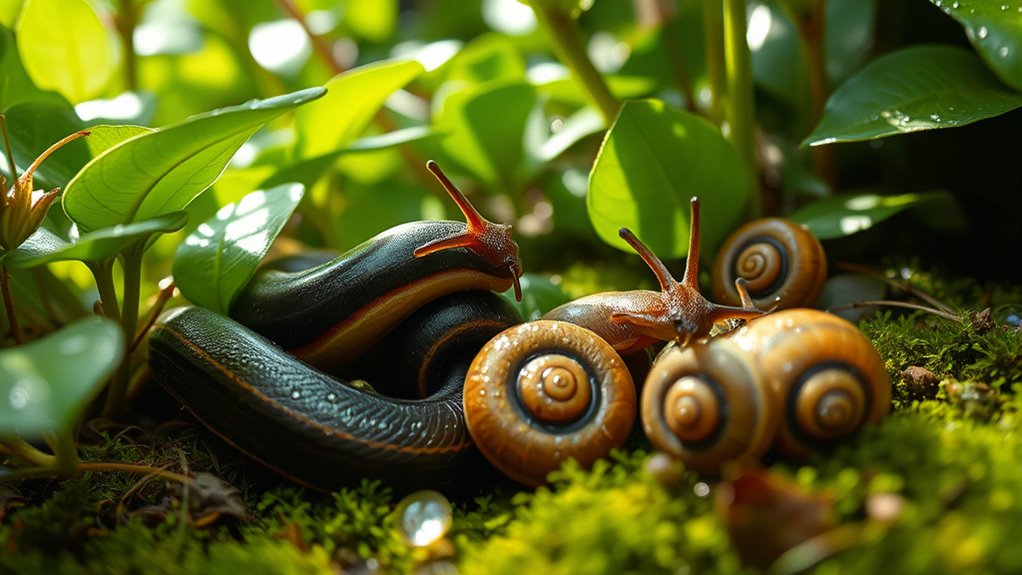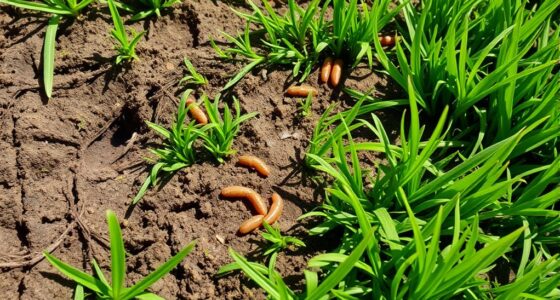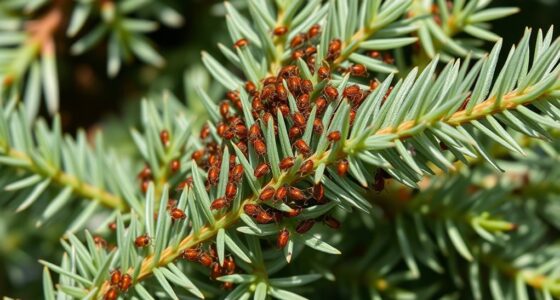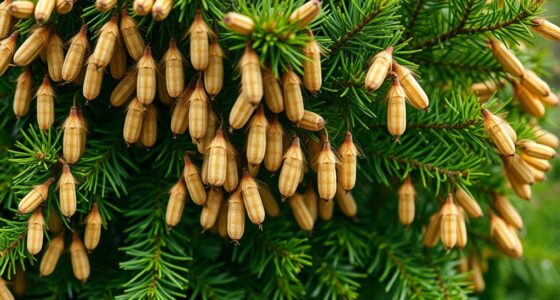Shade gardens attract slugs and snails because they thrive in damp, cool environments often found there. These pests hide under mulch, leaves, or rocks, making early detection important. You can manage them by reducing moisture, removing debris, and using physical barriers like copper tape or diatomaceous earth. Encouraging natural predators and choosing pest-resistant plants also helps keep them in check. Keep exploring to discover more effective ways to protect your shade garden.
Key Takeaways
- Shade gardens attract slugs and snails due to damp, shaded conditions that favor their survival and reproduction.
- Identifying native snail species helps target eco-friendly pest control methods in shaded areas.
- Regularly inspect hiding spots like mulch, leaves, and rocks to detect and manage pests early.
- Moisture management, such as watering early and reducing mulch, discourages slug and snail presence.
- Encouraging natural predators and planting resistant plants can effectively control pests in shade gardens.

Shade gardens may seem like a peaceful retreat, but they often attract slugs and snails that can quickly become pests. These slimy visitors thrive in damp, shaded conditions, and their presence can damage your plants if you’re not vigilant. To keep these pests under control, understanding effective garden pest management is essential. Recognizing the habits of native snail species in your area can help you develop targeted strategies to reduce their impact. Native snails are adapted to your local environment, which means they often reproduce rapidly and are more resilient to certain control methods. Knowing which species are native to your region allows you to tailor your approach, making your efforts more effective and eco-friendly.
Your first step in managing slugs and snails is to identify where they’re hiding during the day. These pests tend to shelter under mulch, leaves, rocks, or any ground cover that maintains moisture. Regularly inspecting these areas helps you spot the pests early before they cause significant damage. Once identified, you can implement physical barriers such as copper tape around plant beds or create barriers using crushed eggshells or diatomaceous earth. These materials act as deterrents, irritating their bodies or making it difficult for them to cross into your plants. Using such garden pest management techniques can considerably reduce their numbers without relying solely on chemical controls.
Inspect mulch and rocks regularly to spot and remove hiding slugs and snails early.
Another effective method involves reducing moisture levels in your garden. Since slugs and snails thrive in damp environments, watering early in the day allows the soil to dry out by night, making conditions less inviting for these pests. Additionally, removing excess mulch, fallen leaves, and plant debris decreases hiding spots, discouraging them from settling in your garden. Consider also setting out beer traps—containers filled with beer placed at ground level. The pests are attracted to the fermentation scent, crawl in, and drown, providing a simple, organic way to reduce their population.
Encouraging natural predators is another part of garden pest management. Birds, beetles, and toads feed on slugs and snails, helping to keep their numbers in check. Creating habitat features like birdhouses or shallow water sources can attract these beneficial creatures. Moreover, planting resistant plants or those less appealing to snails and slugs can minimize damage. Examples include ferns, hostas with copper barriers, or plants with tough, textured leaves.
Frequently Asked Questions
What Are Natural Predators of Slugs and Snails?
You can control slugs and snails naturally by encouraging their predators. Some effective slug predators include birds, beetles, frogs, toads, and ground beetles. Introducing or attracting these animals helps with snail control methods. You might also use natural barriers or traps to keep their numbers down. By supporting these predators, you create a balanced garden environment that reduces slug and snail damage without relying on chemicals.
How Can I Prevent Slugs and Snails From Entering My Shade Garden?
To prevent slugs and snails from entering your shade garden, you should use physical barriers like copper tape or crushed eggshells around plant beds. Additionally, consider companion planting with plants like fennel or garlic that repel these pests. Keep the area tidy, remove debris, and avoid overwatering, as moisture attracts slugs and snails. These methods create an effective defense, reducing their presence and protecting your shade garden.
Are There Organic Methods to Control Slug and Snail Populations?
Imagine your garden as a delicate ballet, and slugs and snails as unwelcome shadows. You can turn the tide organically by using companion planting, like marigolds or garlic, which repel these pests. Biological controls, such as introducing natural predators like nematodes or beetles, act as silent guardians. Together, these methods help keep your shade garden thriving, free of slimy intruders, while respecting nature’s gentle balance.
How Do Soil Types Affect Slug and Snail Activity?
Soil types greatly influence slug and snail activity through soil composition and moisture levels. You’ll notice they thrive in moist, organic-rich soils like loam, which retains water well. Sandy soils drain quickly and are less inviting, reducing their presence. To manage them, improve drainage, reduce soil moisture, and avoid overwatering. Keeping soil drier and less hospitable discourages these pests from thriving in your garden.
Can Certain Plants Naturally Repel Slugs and Snails?
You can naturally repel slugs and snails with certain plants that act as barriers, creating a safe haven for your garden. While garden mulch keeps moisture in, planting barrier plants like lavender or rosemary around your garden can deter pests. These plants emit scents that slugs dislike, offering protection without chemicals. Picture a lush, thriving garden where your choice of barrier plants and mulch keeps unwanted visitors at bay, preserving your garden’s beauty.
Conclusion
Think of slugs and snails as silent guardians of your shade garden’s secret world. Like gentle shadows, they remind you that beauty often hides in quiet places, waiting to be appreciated. Embrace their presence as part of the garden’s story, teaching patience and balance. Just as a moonlit night reveals hidden wonders, your understanding of these creatures uncovers the deeper harmony within your garden’s delicate ecosystem. Embrace the mystery, and let your garden thrive in harmony.









